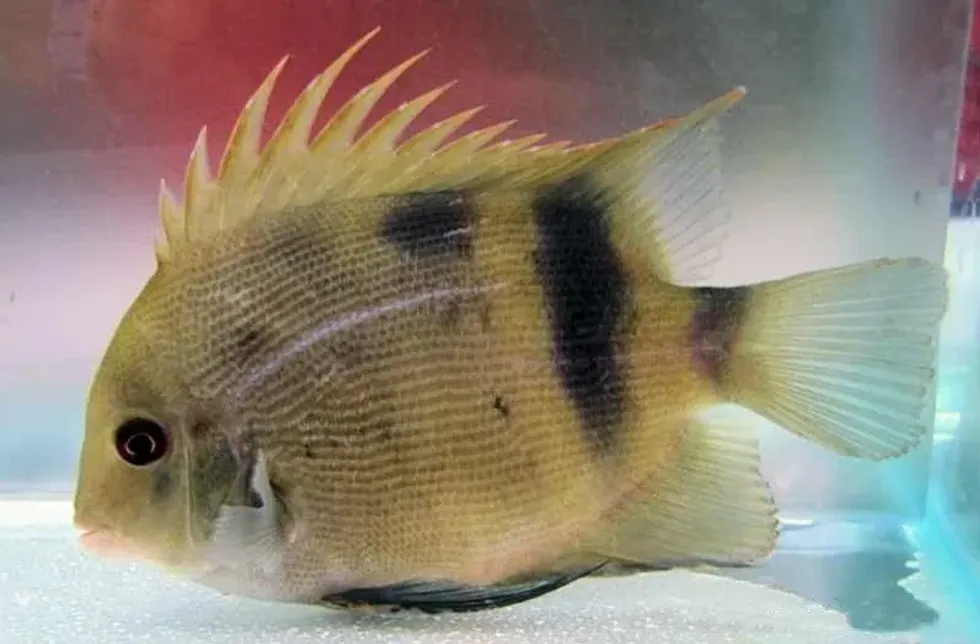The Uaru fernandezyepezi is a type of cichlid fish belonging to the genus Uaru. The other cichlid belonging to this family is the Uaru amphiacanthoides which is also known by the name Uaru cichlid. The Uaru fernandezyepezi is smaller than the Uaru cichlid in size and is generally known by the name Panda Uaru.
The fish gained its name from an ichthyologist, a biologist who studies fishes, Agustin Fernandez Yepez. The name of the genus comes from the Amazonian language's word for toad.
The cichlid is very uncommon to find even in its own place of origin in South America. They are also not exported much from the Colombia-Venezuela border.
Therefore, they are quite rare and expensive to buy. However, fish enthusiasts and aquarium experts still try to keep the fish as a pet and it has even been called the 'Poor man's discus'.
This fish has not yet been bred in an aquarium environment and a young fry has not been seen to develop and mature into an adult in an aquarium. Thus, many hobbyists try to undertake breeding projects for this species. Keep reading for more amazing facts about Uaru fernandezyepezi.
If you liked this article with some great facts about the Uaru fernandezyepezi, then also check out the other articles with great facts about herring and scorpionfish.
Uaru Fernandezyepezi Interesting Facts
What type of animal is an Uaru fernandezyepezi?
An Uaru fernandezyepezi is a type of cichlid fish belonging to the Uaru genus.
What class of animal does an Uaru fernandezyepezi belong to?
The Uaru fernandezyepezi belongs to the Actinopterygii class of animals.
How many Uaru fernandezyepezies are there in the world?
Researchers have not yet been able to record the exact population of this cichlid fish species as they are mostly found in aquatic habitats where it is hard to track them down.
Where does an Uaru fernandezyepezi live?
The Uaru fernandezyepezi is a type of cichlid fish of the Uaru genus whose origin is from South America. It is native to the Rio Atabapo river which forms a part of the Rio Orinoco basin and is situated in the range between the borders of Colombia and Venezuela.
What is an Uaru fernandezyepezi's habitat?
The Uaru fernandezyepezi can survive in both blackwaters and whitewater habitats. Due to its origin and habitat, this fish prefers a freshwater system and can be found in the river basin.
Since this fish inhabits acidic blackwater habitat, the water in their aquarium should also have an appropriate acidic level. Thus, the water in the tank should have a pH level range between 3-4 and soft enough to allow breeding. The temperatures of the water also have to be warm enough for them to be comfortable.
Who do Uaru fernandezyepezies live with?
Uaru fernandezyepezi fish is a type of schooling fish. Therefore, they should not be kept alone in aquariums but can live comfortably with other peaceful medium-sized fishes or other Panda Uarus as long as the tank size is big enough to accommodate all.
How long does an Uaru fernandezyepezi live?
The Uaru fernandezyepezi species has a lifespan of up to 10 years if they are properly taken care of.
How do they reproduce?
The breeding process of Uaru fernandezyepezi is very similar to that of the Uaru cichlid. It is quite difficult to breed them in a tank as they usually form their own mating pairs and are open breeders.
The females prefer a dark area to lay their eggs but may end up eating their own spawn if they cannot see clearly. They also undergo high levels of stress while spawning and as a result might eat their own eggs. However, if they are surrounded by other fish during the process - it may help them calm down.
The female cichlid lays 100-400 eggs per season and both the parents look after it. The eggs hatch after four days and eat the slime on their parents' bodies for sustenance.
What is their conservation status?
The International Union for Conservation of Nature has Not Evaluated the Uaru fernandezyepezi in its Red List yet possibly because they have not been able to evaluate its population trends as of yet.
Uaru Fernandezyepezi Fun Facts
What do Uaru fernandezyepezies look like?

*Please note that this is an image of Uaru amphiacanthoides, not a Uaru fernandezyepezi. If you have an image of Uaru fernandezyepezi please let us know at hello@kidadl.com.
The Uaru fernandezyepezi has a disc-shaped body that is mostly dull yellow or yellow ochre in color. They have prominent black-colored splotch-like marks near the base of their tail. A black-colored vertical band runs down its entire body near the tail. Its tail and fins are of a very fine texture and they have small, round black-colored eyes.
This cichlid species has a second set of pharyngeal teeth situated in their throat in addition to their regular set of teeth. They have spiny rays on their anal, dorsal, pelvic, and pectoral fins to ward off predators.
The young cichlids look different from the adults as they are golden-brown in color and are covered in white speckles.
How cute are they?
The Uaru fernandezyepezi are not extremely cute but they can be admired when kept in an aquarium. Their colorful bodies and complicated fin structure add to their charm.
How do they communicate?
Not much is known about how the Panda Uaru cichlids communicate with each other. However, it is noted that they use physical actions while displaying aggression. In an aquarium, if the cichlid is feeling confrontational towards another fish then they can become quite territorial.
How big is an Uaru fernandezyepezi?
Panda Uarus normally grow up to a length of 12 in (30 cm) in their native wild habitat. However, they only reach up to 10 in (25.5 cm) in length if they live in an aquarium environment.
The Pacific halibut is almost ten times the size of the Uaru fernandezyepezi fish as it usually grows up to 9.8 ft (3 m) in size!
How fast can an Uaru fernandezyepezi swim?
Uaru fernandezyepezi fishes are mostly found in aquariums where the water is quite still and does not have high speed or turbidity. Thus, it would be safe to assume that they are not comfortable swimming at a very fast speed.
The frontal area of their fins is very soft and it helps them to glide through the water effortlessly rather than swimming very fast.
How much does an Uaru fernandezyepezi weigh?
The weight of Panda Uaru cichlids has not yet been determined yet. In addition to that, sexual dimorphism between the males and the females cannot be figured out based on their external physical characteristics alone.
What are the male and female names of the species?
The Panda Uarus do not have any separate, distinct names for the males and females of their species. Therefore, they are usually referred to as male and female Uaru fernandezyepezi.
What would you call a baby Uaru fernandezyepezi?
Female cichlids lay eggs after mating which develop into larva. Consequently, the larva of the Uaru fernandezyepezi develops into young cichlid fishes referred to as 'fry'.
What do they eat?
Uaru fernandezyepezi feeding is quite complex especially for their owners when they live in an aquarium. These cichlids are omnivorous in nature but their diet primarily includes vegetables while they are kept in an aquarium.
They are fed food fish such as granular foods, lettuce, cucumber, soft-leaved aquatic plants, and spinach as a part of their diet. Their diet can also include frozen foods like mosquito larvae, krill, chopped prawns, and shrimp.
It is assumed that they hunt down insects and invertebrates as a part of their diet while they are in the wild habitat.
Are they poisonous?
Uaru cichlid fishes are not known to be poisonous or dangerous to human beings.
Would they make a good pet?
The Uaru fernandezyepezi would make a wonderful pet as they are peaceful cichlids. However, they are not recommended for beginners to look after.
Since they are medium-sized fish, the range of the tank size should be between 100-120 gal (454.6-545.5 L). These cichlids are also comfortable with small tetras and catfishes.
The aquarium should have a proper lighting level to keep the fish comfortable. The lighting should be quite dim and the decor should be dark to suit the cichlid. Their tank and the water in it should also be cleaned regularly in order to maintain hygiene.
The owners can also keep robust plants, like the Microsporum Pteropus, or decorate the tank with plastic plants. This species loves eating soft-leaved plants and would greatly appreciate it if you give them some soft leaves from time to time to munch on.
Did you know...
The Uaru fernandezyepezi cannot be spotted very often even in its own native habitat in the basin of Rio Orinoco. It was first recognized and described by Rainer Stawikowski in 1989. He was also the one to have bred the fish species in captivity for the first time out of its natural environment.
Do they bite?
Panda Uarus are not known to be dangerous or to bite human beings. They are mostly peaceful and are not known to be aggressive.
Do humans eat them?
While a number of cichlid fish species are edible and are eaten in different parts of the world, the Uaru fernandezyepezi species of cichlid is not used for consumption purposes. Their primary economic use is for the aquarium trade.
Here at Kidadl, we have carefully created lots of interesting family-friendly animal facts for everyone to discover! For more relatable content, check out these Siamese fighting fish facts and spiny dogfish facts for kids.
You can even occupy yourself at home by coloring in one of our free printable Uaru Fernandezyepezi coloring pages.










